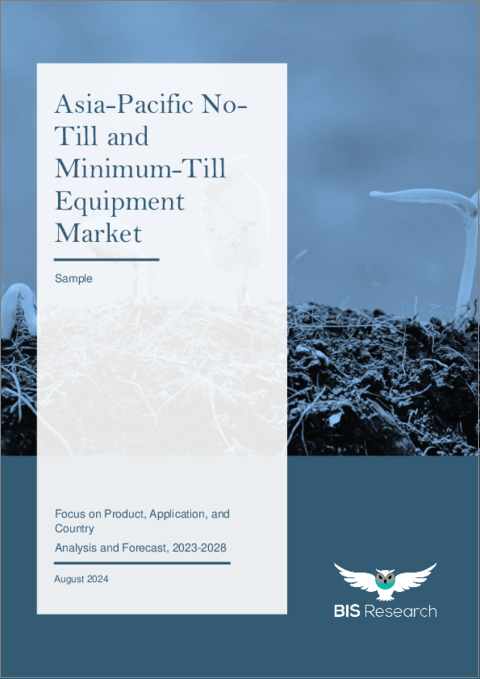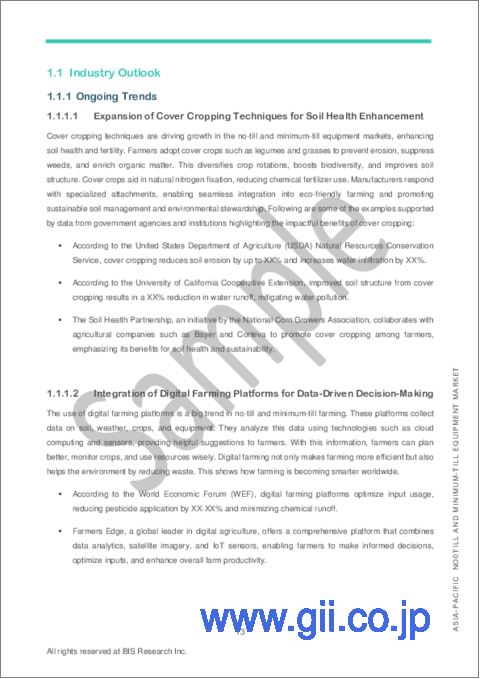|
|
市場調査レポート
商品コード
1532303
アジア太平洋の不耕起・最小耕起装置市場:製品別、用途別、国別 - 分析と予測(2023年~2028年)Asia-Pacific No-Till and Minimum-Till Equipment Market: Focus on Product, Application, and Country - Analysis and Forecast, 2023-2028 |
||||||
カスタマイズ可能
|
|||||||
| アジア太平洋の不耕起・最小耕起装置市場:製品別、用途別、国別 - 分析と予測(2023年~2028年) |
|
出版日: 2024年08月12日
発行: BIS Research
ページ情報: 英文 63 Pages
納期: 1~5営業日
|
- 全表示
- 概要
- 図表
- 目次
アジア太平洋の不耕起・最小耕起装置の市場規模は、2023年には8億560万米ドルになりました。
同市場はCAGR7.35%で成長し、2028年には11億4,850万米ドルに達すると予測されています。不耕起・最小耕起装置市場は、世界の農業界で技術進歩が続いていることから、予測期間中に急成長が見込まれています。被覆作物戦略は、土壌の健全性と肥沃度を高めることにより、不耕起・最小耕起装置産業の成長を後押しします。農家は、浸食を防ぎ、雑草を抑制し、有機物を増やすために被覆作物を使用します。
| 主要市場統計 | |
|---|---|
| 予測期間 | 2023年~2028年 |
| 2023年の評価額 | 8億560万米ドル |
| 2028年の予測 | 11億4,850万米ドル |
| CAGR | 7.35% |
アジア太平洋の不耕起・最小耕起農法市場は、持続可能な農法の採用拡大により急速に拡大しています。不耕起・最小耕起農法は、土壌の撹乱を最小限に抑えることで、土壌水分を保全し、浸食を減らし、土壌の健全性を向上させるのに役立ちます。これらの農法は、投入コストを抑えながら作物収量を増やすことができるため、アジア太平洋の農家の間で人気を集めています。
中国、インド、オーストラリアでは、政府の取り組みや補助金が農家に不耕起農法や最小耕起農法を奨励しています。従来の耕作方法が環境に与える影響に対する意識の高まりも、市場の拡大を後押ししています。さらに、有機食品に対する需要の高まりや、農業における効率的な水管理の必要性が、こうした農法の採用を後押ししています。
同市場には、シードドリルやプランターなど、不耕起・最小耕起農業のための幅広い機器が含まれます。この地域の主要企業は、需要の増加に対応するため、先進的で効率的な機器を導入するための研究開発に投資しています。アジア太平洋の不耕起・最小耕起市場は大幅な成長が見込まれ、農業利害関係者に生産性と持続可能性を向上させる数多くの機会を創出します。
当レポートでは、アジア太平洋の不耕起・最小耕起装置市場について調査し、市場の概要とともに、製品別、用途別、国別の動向、および市場に参入する企業のプロファイルなどを提供しています。
目次
調査範囲
エグゼクティブサマリー
第1章 市場
- 業界展望
- ビジネスダイナミクス
- 資金調達と投資の情勢
第2章 地域
- 中国
- アジア太平洋
- アジア太平洋(国別)
第3章 市場-競合ベンチマーキングと企業プロファイル
- 競合ベンチマーキング
- 競争ポジションマトリックス
- 市場シェア分析
- 企業プロファイル
- KUBOTA Corporation
第4章 調査手法
List of Figures
- Figure 1: Factors Driving the Need for No-Till and Minimum-Till Equipment Market
- Figure 2: Asia-Pacific No-Till and Minimum-Till Equipment Market, $Billion, 2022-2028
- Figure 3: Asia-Pacific No-Till and Minimum-Till Equipment Market (by Application), $Billion, 2022-2028
- Figure 4: Asia-Pacific No-Till and Minimum-Till Equipment Market (by Product), $Billion, 2022-2028
- Figure 5: No-Till and Minimum-Till Equipment Market (by Region), $Billion, 2022
- Figure 6: Soil Fertility Trends After 10 Years (2005-2015) of Conservation Tillage in Organic Farming
- Figure 7: Winter Runoff Analysis: Treatment Comparison and Phase-Specific Means with Standard Errors in the Four-Year Rotation
- Figure 8: Comparison of Average Crop Machinery Cost Per Acre from 2010-2014 using No-Till and Tilled
- Figure 9: Share of Key Market Strategies and Developments, January 2019-November 2023
- Figure 10: Share of Product Development and Innovations (by Company), January 2019-November 2023
- Figure 11: Share of Market Development (by Company), January 2019-November 2023
- Figure 12: Share of Mergers and Acquisitions (by Company), January 2019- November 2023
- Figure 13: Comparison of Percentage of Corn Acres and their Yield Levels in Advanced No-Till and Minimum-Tilled
- Figure 14: Salford Group Inc.(part of Linamar Corporation) - Case Study
- Figure 15: Kinze Manufacturing - Case Study
- Figure 16: Investment and Funding Landscape (by Year), $Million, January 2019-November 2023
- Figure 17: Investment and Funding Landscape (by Company), Share (%), January 2019-November 2023
- Figure 18: Competitive Benchmarking for Key No-Till and Minimum-Till Equipment Providers
- Figure 19: Market Share Analysis of No-Till and Minimum-Till Equipment Market, 2022
- Figure 20: Kubota Corporation: Product and Customer Portfolio Analysis
- Figure 21: Data Triangulation
- Figure 22: Top-Down and Bottom-Up Approach
- Figure 23: Assumptions and Limitations
List of Tables
- Table 1: Key Consortiums and Associations in the No-Till and Minimum-Till Equipment Market
- Table 2: Description and Impact of Government Initiative
Introduction to Asia-Pacific No-Till and Minimum-Till Equipment Market
The Asia-Pacific market for no-till and minimum-till equipment was estimated to be worth $805.6 million in 2023 and is projected to grow at a compound annual growth rate (CAGR) of 7.35% to reach $1,148.5 million in 2028. The market for no-till and minimum-till equipment is expected to grow rapidly over the forecast period, owing to ongoing technological advancements in the global agricultural industry. Cover cropping strategies boost growth in the no-till and minimum-till equipment industries by enhancing soil health and fertility. Farmers use cover crops to prevent erosion, control weeds, and increase organic matter.
| KEY MARKET STATISTICS | |
|---|---|
| Forecast Period | 2023 - 2028 |
| 2023 Evaluation | $805.6 Million |
| 2028 Forecast | $1,148.5 Million |
| CAGR | 7.35% |
Market Introduction
The APAC No-Till and Minimum Till market is expanding rapidly, driven by the growing adoption of sustainable agricultural practices. No-till and minimum-till farming methods help to conserve soil moisture, reduce erosion, and improve soil health by minimizing soil disturbance. These practices are gaining popularity among Asia-Pacific farmers due to their ability to increase crop yield while lowering input costs.
In China, India, and Australia, government initiatives and subsidies are encouraging farmers to use no-till and minimum-till farming methods. The growing awareness of the environmental impact of conventional tillage practices has also aided the market's expansion. Furthermore, the growing demand for organic food products and the need for efficient water management in agriculture are driving the adoption of these practices.
The market includes a wide range of equipment for no-till and minimum-till farming, including seed drills and planters. Key players in the region are investing in R&D to introduce advanced and efficient equipment to meet rising demand. The APAC No-Till and Minimum Till market is expected to grow significantly, creating numerous opportunities for agricultural stakeholders to improve productivity and sustainability.
Market Segmentation
Segmentation 1: by Application
- Farms and Agricultural Fields
- Orchards and Vineyards
- Pastures and Grazing Lands
- Nurseries and Urban Agriculture
- Others
Segmentation 2: by Product
- Seed Drills and Planters
- Cover Crop Seeders
- Cultivators and Tillage Equipment
- Precision Agriculture Technologies
- Others
Segmentation 3: by Country
- Japan
- South Korea
- Australia
- Rest-of-Asia-Pacific
How can this report add value to an organization?
Product/Innovation Strategy: In the dynamic landscape of the no-till and minimum-till equipment market, significant advancements are revolutionizing agricultural practices, with a dedicated focus on optimizing farm performance. Harnessing cutting-edge solutions, including AI-driven analytics and real-time monitoring platforms, no-till and minimum-till equipment provide detailed insights into soil health, crop management, and resource utilization. Innovations such as precision agriculture techniques contribute to efficient farming practices, ensuring optimal crop yield and environmental sustainability. The market encompasses a diverse range of solutions, from state-of-the-art planting equipment to precision seeding systems, empowering farmers to enhance operational efficiency and minimize resource utilization effectively.
Growth/Marketing Strategy: The APAC no-till and minimum-till equipment market is undergoing a remarkable transformation, mirroring the growth strategies observed in the server GPU sector. Key players in the industry are strategically expanding their business horizons, fostering collaborations, and entering partnerships to fortify their global presence. This trend aligns with the shift toward climate-smart agriculture, where companies are not only focused on technological advancements but also on sustainable farming practices. The synergy between technology firms and agricultural experts is driving the development of cutting-edge, climate-smart monitoring tools. Joint ventures and collaborative initiatives are instrumental in integrating diverse expertise, ultimately enhancing the market presence of these climate-smart solutions. This collaborative approach is pivotal in creating comprehensive, user-friendly, and efficient solutions for the evolving landscape of no-till and minimum-till agriculture.
Competitive Strategy: In the ever-evolving landscape of the APAC no-till and minimum-till equipment market, manufacturers are diversifying their product offerings to address a wide range of agricultural needs and practices. Comprehensive competitive analysis underscores the specific capabilities of market participants, showcasing their tailored solutions and specialized knowledge in different regions. Collaborations with agricultural research institutions and technology organizations play a crucial role in fostering innovation and steering the continual transformation of the no-till and minimum-till equipment sector.
Table of Contents
Scope of the Study
Executive Summary
1 Markets
- 1.1 Industry Outlook
- 1.1.1 Ongoing Trends
- 1.1.1.1 Expansion of Cover Cropping Techniques for Soil Health Enhancement
- 1.1.1.2 Integration of Digital Farming Platforms for Data-Driven Decision-Making
- 1.1.1.3 Emerging Automation in No-Till and Minimum-Till Equipment
- 1.1.2 Ecosystem/Ongoing Programs
- 1.1.2.1 Consortiums and Associations
- 1.1.2.2 Government Initiatives and their Impacts
- 1.1.1 Ongoing Trends
- 1.2 Business Dynamics
- 1.2.1 Business Drivers
- 1.2.1.1 Environmental Sustainability and Soil Health
- 1.2.1.2 Water Conservation and Efficiency
- 1.2.1.3 Reduced Chemical Usage and Pesticide Management
- 1.2.1.4 Governmental Support and Policy Initiatives
- 1.2.2 Business Challenges
- 1.2.2.1 Initial Capital Investments
- 1.2.2.2 Supply Chain Disruptions in the No-Till and Minimum-Till Equipment Market
- 1.2.2.3 Knowledge and Skill Gap
- 1.2.3 Market Strategies and Developments
- 1.2.3.1 Business Strategies
- 1.2.3.1.1 Product Development and Innovations
- 1.2.3.1.2 Market Development
- 1.2.3.2 Corporate Strategies
- 1.2.3.2.1 Mergers and Acquisitions
- 1.2.3.2.2 Partnerships, Collaborations, Joint Ventures, and Alliances
- 1.2.3.2.3 Others
- 1.2.3.1 Business Strategies
- 1.2.4 Business Opportunities
- 1.2.4.1 Advanced No-Till and Minimum-Till Equipment Technology
- 1.2.4.2 Eco-Friendly Farming Input Supply Chain
- 1.2.5 Case Studies
- 1.2.1 Business Drivers
- 1.3 Funding and Investment Landscape
- 1.3.1 Funding Analysis (by Year)
- 1.3.2 Funding Analysis (by Company)
2 Regions
- 2.1 China
- 2.2 Asia-Pacific
- 2.2.1 Asia-Pacific (by Country)
- 2.2.1.1 South Korea
- 2.2.1.2 Australia
- 2.2.1.3 Japan
- 2.2.1.4 Rest-of Asia-Pacific
- 2.2.1 Asia-Pacific (by Country)
3 Markets - Competitive Benchmarking & Company Profiles
- 3.1 Competitive Benchmarking
- 3.1.1 Competitive Position Matrix
- 3.1.2 Market Share Analysis
- 3.2 Company Profiles
- 3.2.1 KUBOTA Corporation
- 3.2.1.1 Company Overview
- 3.2.1.2 Product and Customer Portfolio Analysis
- 3.2.1 KUBOTA Corporation
4 Research Methodology
- 4.1 Data Sources
- 4.1.1 Primary Data Sources
- 4.1.2 Secondary Data Sources
- 4.2 Market Estimation and Forecast
- 4.2.1 Factors for Data Prediction and Modeling






